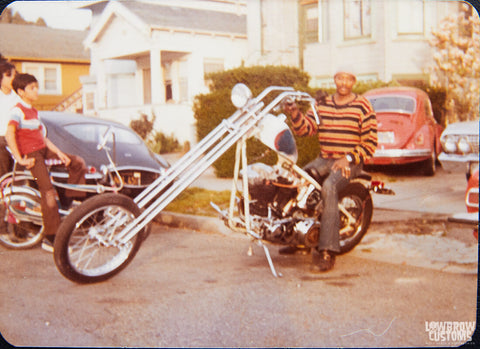Triumph motorcycles are widely hailed as one of the world’s most legendary and respected British brands, boasting a storied legacy that traces back to the early 20th century. In 1902, the Triumph Cycle Co. Ltd. produced its first motorcycle in Coventry, England—a momentous step in the company’s history that paved the way for countless notable models in Triumph motorcycle models history. Before entering the realm of motorcycle manufacturing, this pioneering firm first imported sewing machines and sold bicycles, laying the groundwork for what would become an iconic name in the annals of Triumph motorcycle company history.
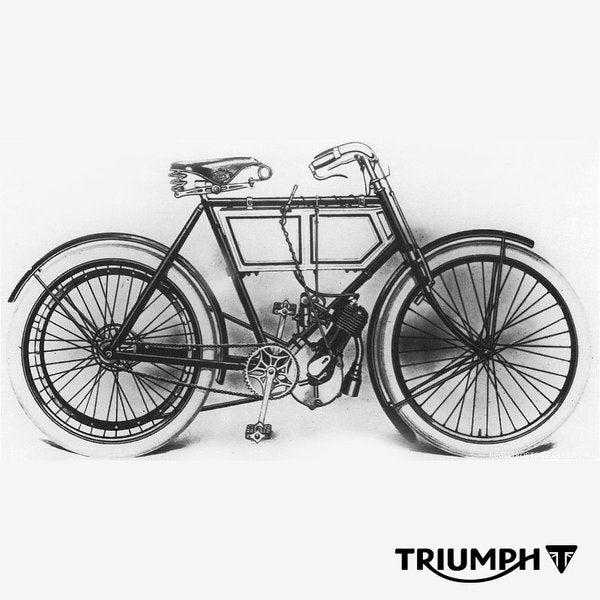
- Drawling of the very first Triumph Motorcycle.
The first Triumph motorcycle essentially consisted of a 2.2 horsepower single-cylinder Belgian Minerva engine that was attached to the downtube on a bicycle frame. Triumphs were powered by Belgian Minerva engines, followed by JAP engines until 1905, when the first all-Triumph models were introduced.

- Triumph reached out to Rev Basil H. Davies a.k.a. Ixion a famous writer (pictured above) to test their very first motor made in 1905.
By 1907, Triumph solidified its reputation as a pioneer in motorcycling, producing a 450cc model that quickly gained acclaim in competitive racing. This period marked the emergence of early Triumph motorcycles as a formidable force in the industry. With production reaching 1,000 cycles per year, Triumph demonstrated its commitment to innovation and quality.
Throughout the 20th century, Triumph continuously advanced its designs, introducing groundbreaking models that shaped the industry. During both World Wars, Triumph contributed significantly by producing motorcycles and components for military use, solidifying its reputation as a reliable and innovative manufacturer. By the mid-20th century, Triumph’s bikes became symbols of durability and performance, adored by riders worldwide.
In 1937, the company debuted the new 500cc Speed Twin model. This attractive and powerful cycle delivered 27 horsepower and could attain speeds of 90 mph, setting a new benchmark for motorcycle design. The Speed Twin’s lightweight frame, vertical twin engine, and distinctive aesthetics made it a favorite among riders and cemented Triumph’s legacy as a leader in the motorcycling world.
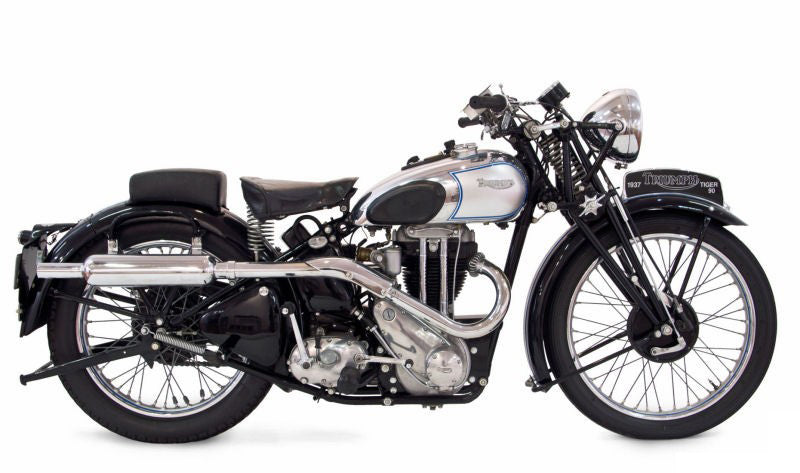
- Triumph 1937 Tiger 90 NZ 500cc engine could go up to 90mph. Photo by: Manxnorton.com
The motorcycling public embraced the sleek and ruggedly attractive Speed Twin right from the start. With its vertical twin engine, lightweight frame, comfortable springer seat and four-speed transmission, this cycle possessed several distinctive features that set it apart from all other motorcycles.
The parallel twin engine, the Amal carburetor, and the iconic Triumph fuel tank accentuated with the rubber knee pads and Triumph logo lasted on many Triumph models for decades to come. Even with the early Speed Twin models, the sleek lines of the Triumph motorcycles gave them an eye-catching appearance that appealed to riders everywhere.
In 1938, a small motorcycle shop in California began selling Triumphs, BSAs and other types of imported cycles. The Triumph models, especially the T100, quickly turn out to be popular items with cycling consumers. At the racetracks, Triumph motorcycles such as the Tiger 80 and the T100 were setting new performance records by 1939.
After a devastating wartime bombing in Coventry in 1940, the Triumph factory was destroyed. Two years later, the company began producing motorcycles again, in Meriden, England. Production of Triumphs continued at this site until 1983.
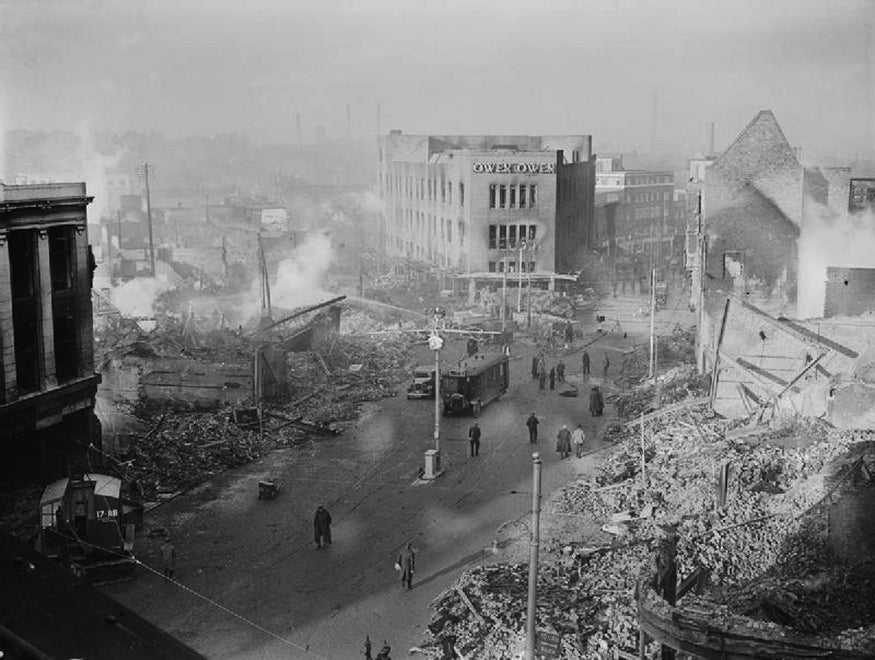
- Images after the Coventry damage in 1940.
With World War II taking place at the time, the motorcycles produced at the Meriden facility until 1946 were made for military use. Approximately 40,000 Triumph cycles were produced for military use during the war, and many of these bikes were repainted and put into civilian use when the war ended.
During World War II, Triumph also produced various products for the war effort, including stretcher carriers, steering housings, generators and aircraft components.
When the production of civilian model Triumphs resumed in 1946, the company focused on producing the Speed Twin, as well as the 350cc 3T touring bike, and the Tiger 100.
By 1948, Triumph was producing 12,000 motorcycles per year, with more than half that number being exported. The 500cc Trophy TR5 model, which was the first trail bike made by Triumph, was introduced in 1948.
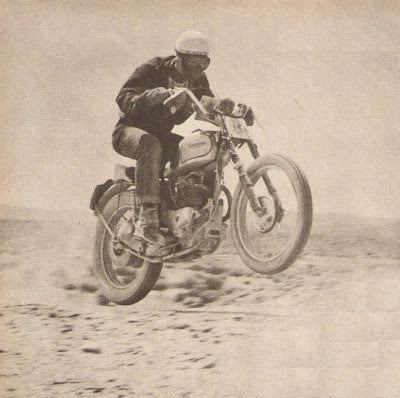
- A 1949 Triumph TR5 motorcycle in action.
The 650cc Thunderbird 6T was introduced in 1949, as was the TR5 Trophy model. Both of these models were very popular with American riders, with beefed-up versions of the TR5 becoming favorite models for racing until the late 1960s. The Triumph Owners Motorcycle Club was also founded in 1949.
In 1950, the U.S.-based Triumph Corporation was formed, with the purpose of creating a distribution network for Triumph motorcycles on America's east coast. Beginning in the early 1950s, more Triumphs are sold in America than any other country.
Also in the early 1950s, some of the World War II veterans who became familiar with Triumphs and other types of motorcycles during the war, started riding motorcycles in civilian life. Sometimes, these machines were outfitted with custom and high performance parts, giving the cycles an unusual appearance.

- Marlon Brando with his Triumph 6T for the movie "The Wild Ones".
In late 1953, an action-adventure motion picture named "The Wild One" is released. In this movie, lead actor Marlon Brando plays the leader of a motorcycle club that wreaks havoc on a small California town during a scheduled motorcycle race. The type of motorcycle that Brando rides in the movie is a Triumph 650cc Thunderbird 6T.
In 1955, a streamliner racer powered by a 650cc Triumph engine is clocked at 193 mph at the Bonneville Salt Flats. For almost the next 15 consecutive years, Triumph holds the world motorcycle land speed records.

- Johnny Allen riding "The Devils Arrow" broke the overall fastest motorcycle record by flying down the Bonneville Salt Flats at 193.7 mph in 1955. The Stream liner was 15.7 foot-long and powered by a methanol burning, 1950 Triumph Thunderbird 650 twin motor.
The most iconic and best-selling model in Triumph motorcycle history is undoubtedly the Bonneville. Produced from 1959 to 1983, this sporty and powerful bike became the epitome of British motorcycle engineering. When the first model of the Bonneville twin introduced in 1959, it featured mudguards and a nacelle—a design that initially failed to captivate the motorcycling public. However, the Bonneville soon evolved, with later versions gaining widespread acclaim and solidifying its status as a cultural icon in the motorcycling world.

- A vintage ad for the Triumph Bonneville 120.
With the growing fascination with motorcycles in popular culture, Triumph motorcycles in particular, experienced a huge surge in popularity during the 1960s. Many people considered Triumphs, like Harley-Davidsons, to be "cool" types of motorcycles.
In the 1963 action/adventure film "The Great Escape" actor Steve McQueen rode a TR6 650 Trophy, sparking a renewed public interest in the Triumph brand. 1963 was the year in which unit construction engine/ gear boxes on all 650cc models began, and also when the Triumph Tina 100cc motor scooter was introduced.
The size and sound of Triumphs, as well as the high performance capabilities and renegade image that the bikes possessed made them ideal vehicles to customize. Builders of custom chopper and bobber-style motorcycles everywhere found that Triumphs and Harley-Davidsons were usually the most desirable brands of bikes to customize.
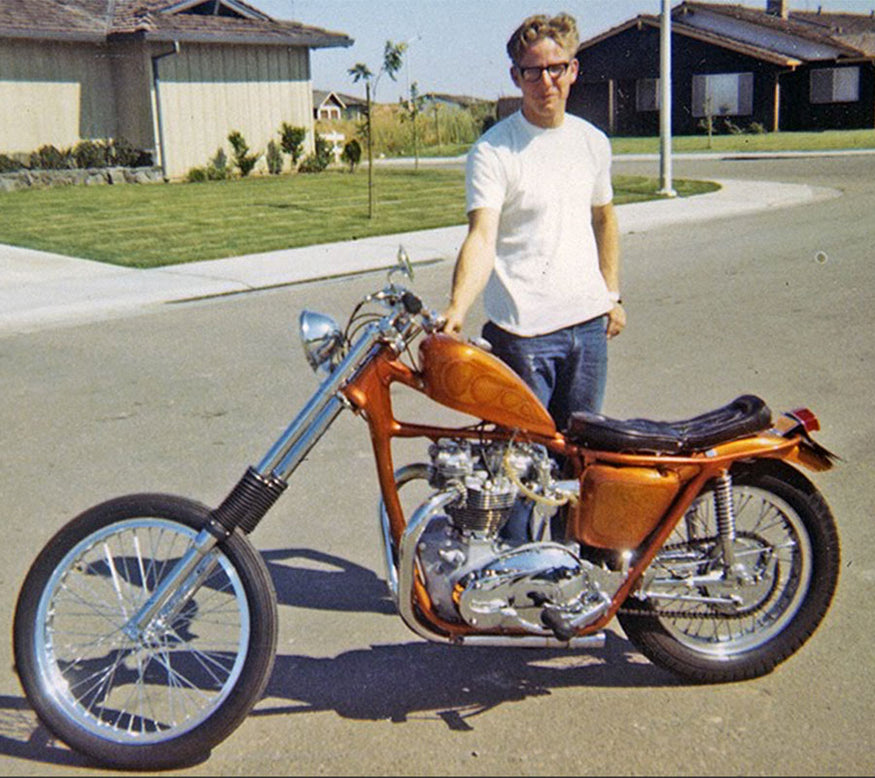
- 1965 Triumph 650. Photo Jeff McCann via 1968.
During the early through mid-1960s, Triumph motorcycles fairly dominated the world of motorcycle racing, with all sorts of new performance records being established. To celebrate Triumph's 1966 victory at Daytona, the 500cc Tiger 100 Daytona model was introduced in 1967.
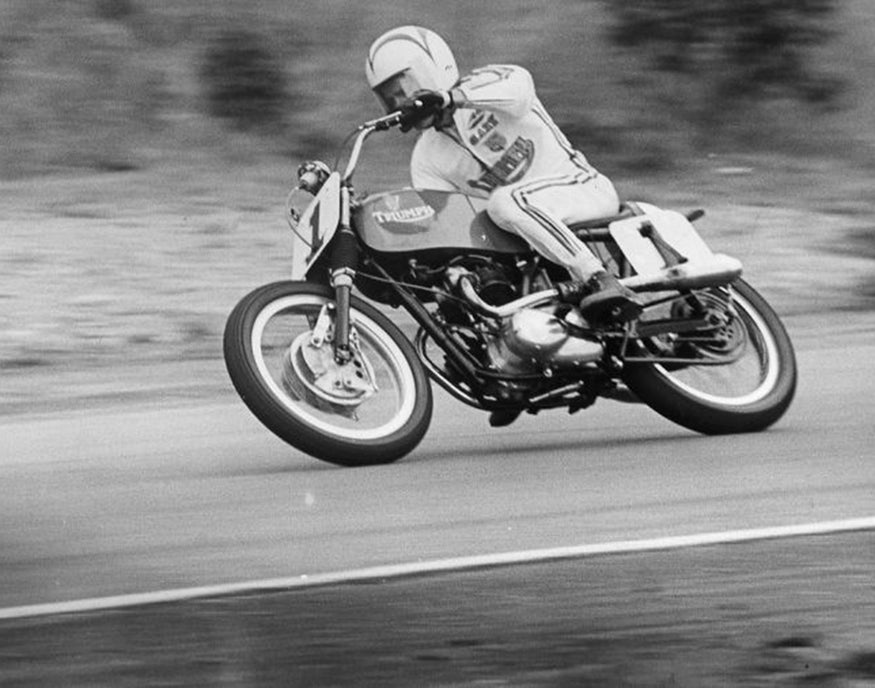
- 1967-68 Daytona winner and AMA Grand National champion, Gary Nixon, on a Triumph 500.
The three-cylinder Triumph Trident T150 debuted in 1968. A cooperative effort by Triumph and BSA, the Trident offered 58 horsepower and a top speed of 125 mph. Also in 1968, famous motorcycle stunt rider Evel Knievel attempted to jump over the large outdoor fountain at a Las Vegas casino while riding a Triumph Bonneville.
Triumphs' domination in motorcycle racing continues into 1970, with Trident models taking the top three qualifying speeds at Daytona. The highest speed presented was 165 mph.
In 1975, workers at the Meriden Triumph factory formed a workers' cooperative in an effort to keep the company running. The production of Bonneville and Tiger models continued there until 1983. In 1983, the Triumph factory in Meriden closed its doors, leaving the future of Triumph motorcycles in question.

- Inside the Triumph factory in Meriden.
When the Meriden facility closed, a wealthy developer who was interested in purchasing the site, decided to save the Triumph brand from extinction by purchasing the Triumph name and all manufacturing rights. From 1983 through 1988, the new owner licensed a Triumph chopper parts manufacturer to produce a small numbers of Bonnevilles.
In 1990, the Triumph company resumed higher production numbers and six new models were introduced to the world. The powerful Speed triple model was unveiled in 1994, and the new factory in Hinckley was completed.
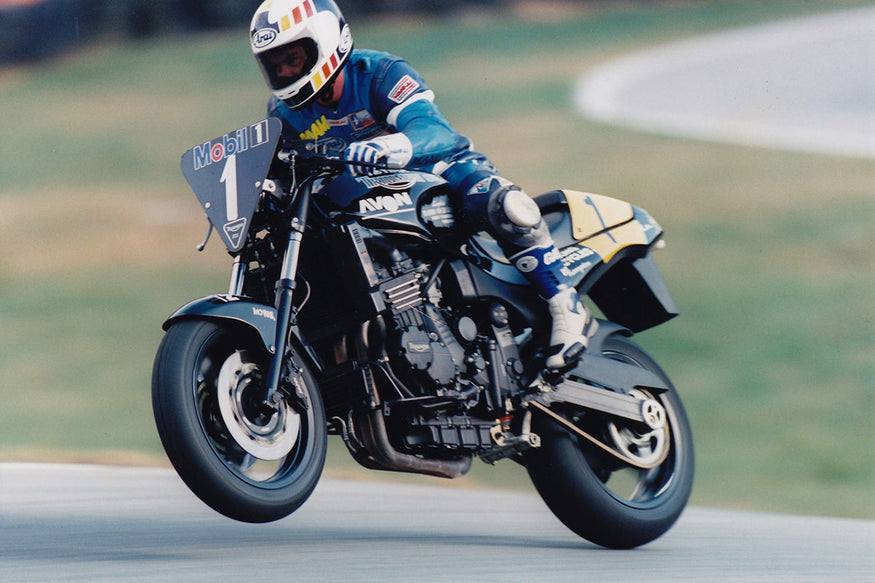
- Mobil 1 Triumph Speed Triple Challenge. Cadwell Park, 1995. Neil Young Motorcycles.
In 1995, Triumph began selling bikes in the U.S. again, with production at roughly 12,000 cycles per year. By 1996, 50,000 motorcycles had been manufactured at the Hinckley plant.
A large fire caused extensive damage at the Hinckley assembly plant in 2002, but the factory was rebuilt in just a few months.
The 2000s ushered in a new chapter for Triumph motorcycles, showcasing a diverse lineup that blended modern technology with the brand’s timeless charm. Iconic models such as the Rocket III, Triple Daytona, Street Triple, and Tiger 800 catered to different riding styles, from power and speed to agility and adventure. Meanwhile, the Speedmaster and Thunderbird Storm highlighted Triumph’s dedication to combining performance with classic design. Interestingly, many current Triumph models pay homage to their predecessors, maintaining the sleek lines and distinctive aesthetics that have defined the history of Triumph motorcycles for over a century.
Many enthusiasts often wonder where Triumph motorcycles are made. Despite a global presence, Triumph has six world-class factories: two in Hinckley, England—just a stone’s throw from the Mallory Park race track—three in Chonburi, Thailand, and one in Manaus, Brazil. Every Triumph motorcycle begins its journey in Hinckley, where the design work, prototype construction, and engineering all take place. It’s great to see that Triumph motorcycles are still being produced in England. The Triumph brand has gone through a series of twists and turns over the past 100-plus years, and although there have been many changes since 1902, the rich heritage of Triumph motorcycles still lives on today, firmly rooted in the UK.
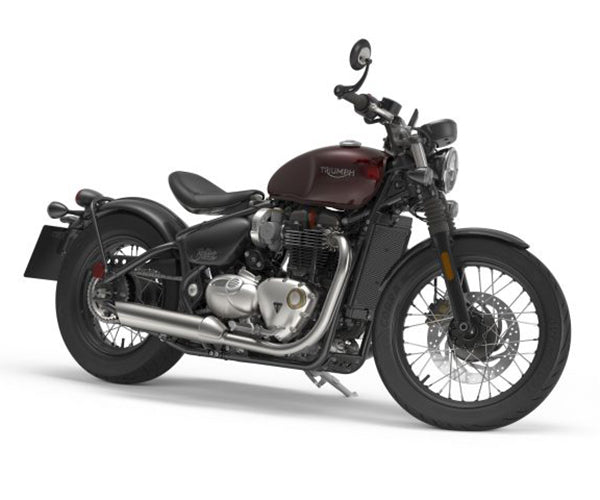
- Triumph's latest release to the market the "Triumph Bobber". Taking roots from the T120 and custom stylings this 1200cc motor has the classic style with modern features.
Related Products









